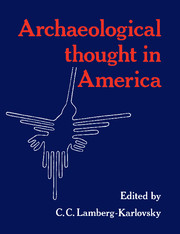Book contents
- Frontmatter
- Contents
- List of illustrations
- Introduction
- Part I History, method, and theory
- Part II Archaeology in the Americas and beyond
- 9 The structural analysis of Paleolithic art
- 10 Ancient China and its anthropological significance
- 11 Settlement pattern studies and evidences for intensive agriculture in the Maya Lowlands
- 12 The political economy of the Inka empire: the archaeology of power and finance
- 13 An epigenetic view of the Harappan culture
- 14 The use and abuse of world systems theory: the case of the “pristine” West Asian state
- 15 Mesopotamia, Central Asia and the Indus Valley: so the kings were killed
- 16 New tracks on ancient frontiers: ceramic technology on the Indo-Iranian Borderlands
- 17 Pastoralism and the early state in Greater Mesopotamia
- References
- Index
15 - Mesopotamia, Central Asia and the Indus Valley: so the kings were killed
Published online by Cambridge University Press: 06 July 2010
- Frontmatter
- Contents
- List of illustrations
- Introduction
- Part I History, method, and theory
- Part II Archaeology in the Americas and beyond
- 9 The structural analysis of Paleolithic art
- 10 Ancient China and its anthropological significance
- 11 Settlement pattern studies and evidences for intensive agriculture in the Maya Lowlands
- 12 The political economy of the Inka empire: the archaeology of power and finance
- 13 An epigenetic view of the Harappan culture
- 14 The use and abuse of world systems theory: the case of the “pristine” West Asian state
- 15 Mesopotamia, Central Asia and the Indus Valley: so the kings were killed
- 16 New tracks on ancient frontiers: ceramic technology on the Indo-Iranian Borderlands
- 17 Pastoralism and the early state in Greater Mesopotamia
- References
- Index
Summary
… down in the dust lay the ancient majesty of thrones, the haughty sceptres. The illustrious emblem of the sovereign head, dabbled in gore and trampled under the feet of the rabble, mounted its high estate.
LucretiusThe earliest civilizations in the three regions of our concern have been termed Sumerian (Mesopotamia), Namazga (Central Asia), and Harappan (Indus Valley). Archaeologists, almost as one, hold firm to the conviction that each of the above civilizations is at least partly the result of an indigenous, autonomous process of development. In each case the distinctive nature of their material remains, their geographical separation, and most particularly the differing cultural traditions so apparent in the material culture that characterized each area prior to the emergence of urban complexity provide substantial support for their indigenous emergence. This is not to say, however, that particular forms of social relations, particularly of a commercial nature, did not provide an integrative force with their adjacent frontiers. The chronological priority of the Sumerian civilization over the Harappan is simply not sufficient for claiming that “it can at least be averred that, however translated, the idea of civilization came to the Indus from the Euphrates and Tigris, and gave the Harappans their initial direction, or at least informed their purpose” (Wheeler 1968b: 135).
- Type
- Chapter
- Information
- Archaeological Thought in America , pp. 241 - 267Publisher: Cambridge University PressPrint publication year: 1989
- 4
- Cited by

